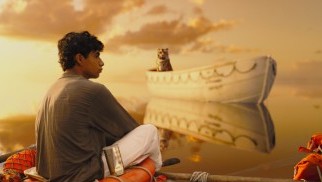‘Life of Pi’ finds spirituality among the waves of the ocean, roars of the tiger

Ang Lee’s Life of Pi is one of the most beautiful films of all time. One could play the entire movie on mute, and it would still cause an emotional reaction. The visuals are captivating in their sheer artistry. Whether making the ocean look like a calm lake or a mighty beast, Lee has a way of lensing this picture like no other film he’s completed.
The fact that it tells an equally invigorating story seems like icing on the cake.
Suraj Sharma plays the title character, a young Indian man finding himself in the most unlikeliest of situations. After growing up tending to the animals in his parents’ zoo, he’s unwillingly taken on a transglobal boat ride from India to Canada, where his family plans to relocate. The ship is no cruise liner, featuring a mean French cook (Gérard Depardieu) and little luxury. Worse still, Pi’s family has brought all of the zoo animals and stowed them in the depths of the ship. It’s a floating Ark.
When the seas start getting choppy and the inevitable storm hits like an act of god, Pi finds himself tossed and torn between life and death. In several harrowing scenes, he’s catapulted from the ship and lands on a lifeboat. His family appears to be lost at sea, along with the animals.
It would take a man of great faith to survive in the middle of the ocean, and thankfully Pi is a man of many faiths. As a young child, he became a practitioner of every religion in the book, from Islam to Christianity to Judaism and Hinduism. He has many gods to pray to, but with each passing day and each new challenge he begins to lose his hold on spirituality.
Adding to the misery is the Bengal tiger that somehow found its way onto the lifeboat. Now, Pi needs to survive the elements, starvation, dehydration and the threats of a man-eater lurking a few feet away.
This back-and-forth between the nervous Pi and the ferocious tiger becomes the main heart of this exquisite film. Based on the book by Yann Martel, David Magee’s script honors the original text and offers many opportunities for Lee to flex his creative muscles.
The plot may sound like a wonderful adventure flick, but Life of Pi is so much more than special effects. The revelations that spin through Pi’s head are weighty material. He questions everything that a normal person questions, from the existence of God to the frailty of men. He hates the tiger and then learns to love him. He experiences the beautiful painting of the heavens, constantly wondering how to connect the dots.
We learn of Pi’s journey with 20-20 hindsight, mostly because the movie is bookended by a series of scenes depicting Pi as an older man living in Canada. His ultimate fate (spoiler alert) doesn’t matter one bit. We know he survives the crash. We know the outcome from the very beginning. Life of Pi teaches us that the journey is much more resonant than the final destination.
The visuals need to be experienced on a large screen in High Definition. Lee’s film is also a rare breed: a movie that should be experienced in 3D. Let the imagery pop off the screen, grabbing you and shaking you. See the whale jump from the ocean, dancing among the constellations of the night. See the mirror image of the calm seas, making it look like a Hollywood set. See the island of mysterious poisons. See the tiger bounce back and forth (and I’m still not sure what scenes feature CGI and what scenes feature real animals). See it all.
Life of Pi may be the best movie of 2012. It’s that good, a gift from God.
By John Soltes / Publisher / John@HollywoodSoapbox.com
-
Life of Pi
-
2012
-
Directed by Ang Lee
-
Written by David Magee
-
Based on the book by Yann Martel
-
Starring Suraj Sharma, Irrfan Khan and Rafe Spall
-
Running time: 127 minutes
-
Rated PG
-
Rating:





